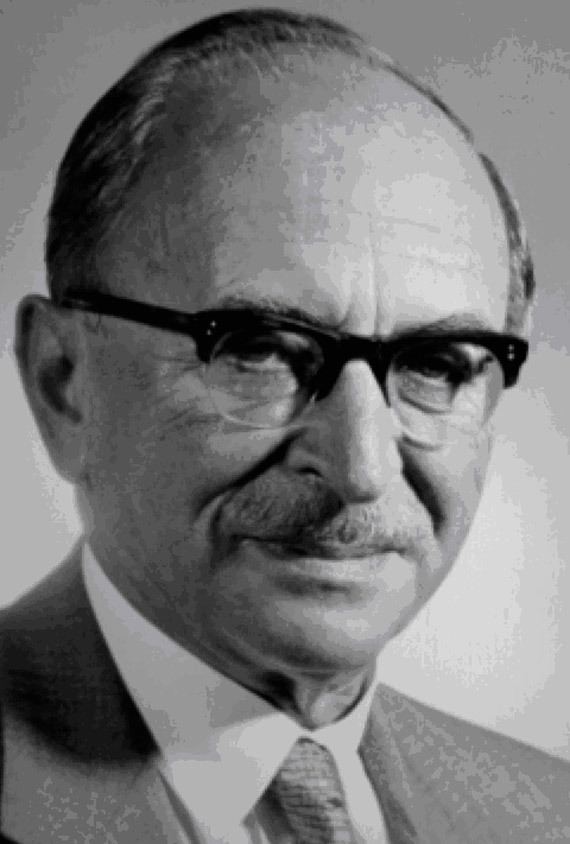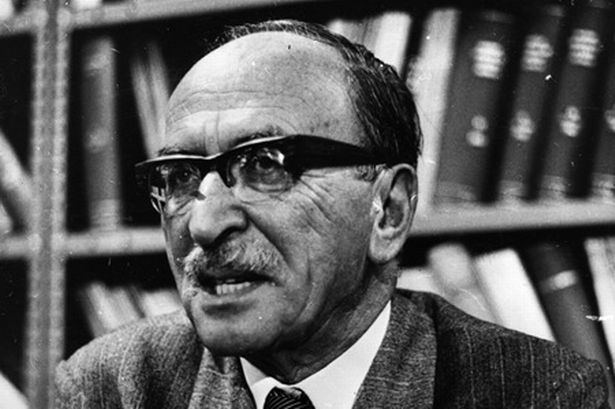Name Dennis Gabor Role Physicist | ||
 | ||
Institutions Imperial College LondonBritish Thomson-Houston Known for HolographyGabor filterGabor limitGabor transformGabor atomGabor wavelet Died February 9, 1979, London, United Kingdom Books Inventing the Future Notable awards Royal Society (1956) Similar People Anthony G Constantinides, Edward Teller, George Andrew Olah | ||
Episode 2 go on give us another wave dennis gabor 1971
Dennis Gabor (; Hungarian: Gábor Dénes; 5 June 1900 – 9 February 1979) was a Hungarian-British electrical engineer and physicist, most notable for inventing holography, for which he later received the 1971 Nobel Prize in Physics.
Contents
- Episode 2 go on give us another wave dennis gabor 1971
- Dennis gabor biography
- Life and career
- Personal life
- Awards and honors
- In popular culture
- References

Gábor Dénes College in Budapest, Hungary is named after him in honor of his works.

Dennis gabor biography
Life and career

Gabor was born as Günszberg Dénes, into a Jewish family in Budapest, Hungary. In 1918, his family converted to Lutheranism. Dennis was the first-born son of Günszberg Bernát and Jakobovits Adél. Despite having a religious background, religion played a minor role in his later life and he considered himself agnostic. In 1902, the family received permission to change their surname from Günszberg to Gábor. He served with the Hungarian artillery in northern Italy during World War I. He began his studies in engineering at the Technical University of Budapest in 1918, later in Germany, at the Charlottenburg Technical University in Berlin, now known as the Technical University of Berlin. At the start of his career, he analysed the properties of high voltage electric transmission lines by using cathode-beam oscillographs, which led to his interest in electron optics. Studying the fundamental processes of the oscillograph, Gabor was led to other electron-beam devices such as electron microscopes and TV tubes. He eventually wrote his PhD thesis on Recording of Transients in Electric Circuits with the Cathode Ray Oscillograph in 1927, and worked on plasma lamps.

In 1933 Gabor fled from Nazi Germany, where he was considered Jewish, and was invited to Britain to work at the development department of the British Thomson-Houston company in Rugby, Warwickshire. During his time in Rugby, he met Marjorie Louise Butler, and they married in 1936. He became a British citizen in 1946, and it was while working at British Thomson-Houston that he invented holography, in 1947. He experimented with a heavily filtered mercury arc light source. However, the earliest hologram was only realised in 1964 following the 1960 invention of the laser, the first coherent light source. After this, holography became commercially available.
Gabor's research focused on electron inputs and outputs, which led him to the invention of re-holography. The basic idea was that for perfect optical imaging, the total of all the information has to be used; not only the amplitude, as in usual optical imaging, but also the phase. In this manner a complete holo-spatial picture can be obtained. Gabor published his theories of re-holography in a series of papers between 1946 and 1951.
Gabor also researched how human beings communicate and hear; the result of his investigations was the theory of granular synthesis, although Greek composer Iannis Xenakis claimed that he was actually the first inventor of this synthesis technique. Gabor's work in this and related areas was foundational in the development of time–frequency analysis.
In 1948 Gabor moved from Rugby to Imperial College London, and in 1958 became professor of Applied Physics until his retirement in 1967. His inaugural lecture on 3 March 1959, 'Electronic Inventions and their Impact on Civilisation' provided inspiration for Norbert Wiener's treatment of self-reproducing machines in the penultimate chapter in the 1961 edition of his book Cybernetics.
In 1963 Gabor published Inventing the Future which discussed the three major threats Gabor saw to modern society: war, overpopulation and the Age of Leisure. The book contained the now well-known expression that "the future cannot be predicted, but futures can be invented." Reviewer Nigel Calder rephrased the concept as, "The best way to predict the future is to invent it." Others such as Alan Kay, Peter Drucker, and Forrest Shaklee who have used various forms of the quote have been incorrectly credited with coining it. His next book, Innovations: scientific, technological, and social which was published in 1970, expanded on some of the topics he had already earlier touched upon, and also pointed to his interest in technological innovation as mechanism of both liberation and destruction.
In 1971 he was the single recipient of the Nobel Prize in Physics with the motivation "for his invention and development of the holographic method" and presented the history of the development of holography from 1948 in his Nobel lecture.
While spending much of his retirement in Italy at Lavinio Rome, he remained connected with Imperial College as a Senior Research Fellow and also became Staff Scientist of CBS Laboratories, in Stamford, Connecticut; there, he collaborated with his lifelong friend, CBS Labs' president Dr. Peter C. Goldmark in many new schemes of communication and display. One of Imperial College's new halls of residence in Prince's Gardens, Knightsbridge is named Gabor Hall in honour of Gabor's contribution to Imperial College. He developed an interest in social analysis and published The Mature Society: a view of the future in 1972. He also joined the Club of Rome and supervised a working group studying energy sources and technical change. The findings of this group was published in the report Beyond the Age of Waste in 1978, a report which was an early warning of several issues that only later received widespread attention.
Following the rapid development of lasers and a wide variety of holographic applications (e.g., art, information storage, and the recognition of patterns), Gabor achieved acknowledged success and worldwide attention during his lifetime. He received numerous awards besides the Nobel Prize.
Gabor died in a nursing home in South Kensington, London, on 9 February 1979. In 2006 a blue plaque was put up on No. 79 Queen's Gate in Kensington, where he lived from 1949 until the early 1960s.
Personal life
On 8 August 1936 he married Marjorie Louise Butler with whom he lived in a harmonic marriage. They did not have any child.
Awards and honors
Gabor won numerous awards including:
The International Society for Optical Engineering (SPIE) presents its Dennis Gabor Award annually, "in recognition of outstanding accomplishments in diffractive wavefront technologies, especially those which further the development of holography and metrology applications."
The NOVOFER Foundation of the Hungarian Academy of Sciences annually presents its International Dennis Gabor Award, for outstanding young scientists researching in the fields of physics and applied technology.
The Gabor Medal is awarded by the Royal Society of London for "acknowledged distinction of interdisciplinary work between the life sciences with other disciplines".
